Planning how you’re going to layout and hang your drywall sheets is crucial.
It can save you time and reduce the amount on joints required.
Reduce End & Butt Joints
To layout the way the drywall is to be mounted, the studs should be either 16″ on center or 24″ in some cases, and a drywall width of 48″ is standard.
This translates to points of attachment every 16″ on center, with the tapered edges ending midway across the stud surface wherever there is a continuation.
The idea, is to maximize the tapered joints and minimize the end, or butt joints (already on the stock panel or a result of cutting).
This is because the butt joints require more time and effort to achieve an even finish.
To accomplish this, as a rule, the biggest sheets should be installed wherever they feasibly can.
Drywall Sheet Sizes
Drywall is available in 8′, 10′, 12′, 14′ and 16′ lengths, but sheets beyond 12′ normally require special order and a minimum quantity.
An 8′ sheet is about as much as most one person installers can handle and larger sheets will mean a two person operation. Two is always best.
For 8 foot walls or Less
For an 8′ tall wall, the length of the wall is the determining factor.
For walls 8′ or less, 4 x 8′ sheets can be mounted vertically with a single tapered seam down the center. Those walls between single and double sheets will be cut to fit.
For Walls Between 8′ and 10′
For walls between 8′ and 10′ the sheets should be cut down, to sidestep any end butt seams albeit with a up to a 2′ cut resulting for lengths between 8′ and 10′.
The installer must constantly assess sheet size with seams.
If you are handling by yourself, it is clearly easiest to hang in 8′ sections. As drywall installed vertically in 4′ width’s will have no butt joints — a fact not to overlook.
The drawback to hanging multiple vertical sheets means there is more lineal feet of seams to finish.
Undoubtedly the larger sheets will reduce the lineal footage of seams to be finished while keeping the seams tapered — however these size sheets simply aren’t as easily handled due to their potential 75 lb weight and dimensions (16′).
Dealing with Larger Sheets
With the larger sheets, hanging the drywall with a partner is a must.
It is safest, and simply easier — with one installer holding in place while the other drives screws, for instance.
In many settings, a combination of larger and standard sheet sizes works well. Although butt joints, if necessary, should really not be stacked one on top the other continuously, this makes them obvious to the eye.
An improved scenario is where the joints are offset with the same dimension sheets being installed. Since the size of the panel is probably a limiting factor from the start, this is generally a workable solution.
For 9′ ceilings, there are 54″ wide sheets in 12′ lengths, which will reduce the seams and eliminate the entire, lengthwise cut.
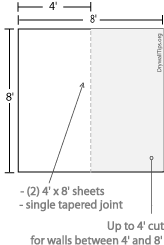
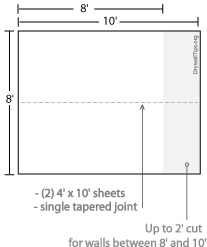
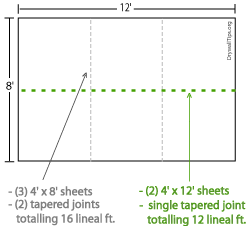
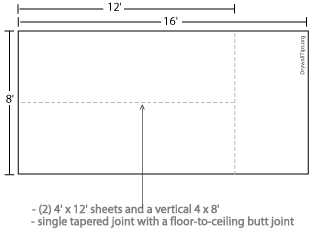
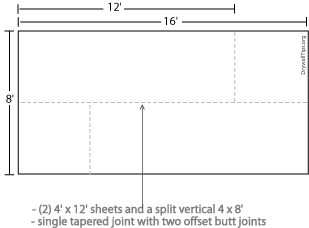
Reader Interactions